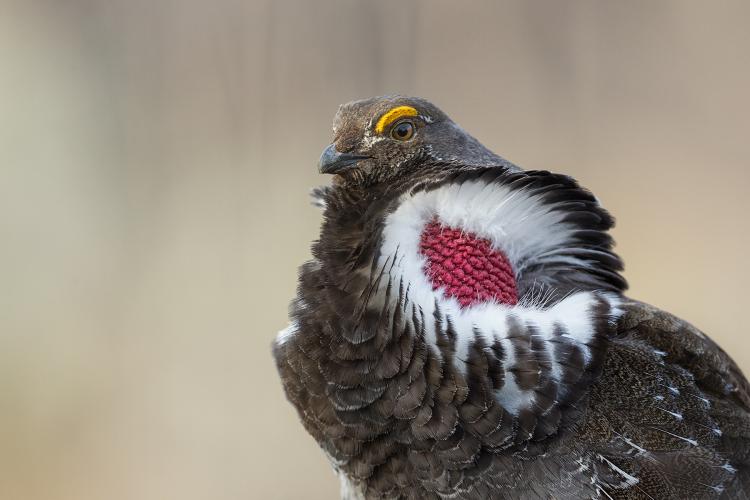Male dusky grouse are masters of camouflage but dandies on the dance floor
Dusky grouse are effectively camouflaged and cryptic much of the year, but when it comes to the spring mating season, the males are bright and bold
In the early 1800s, as the expedition led by Lewis and Clark and guided by Sacagawea pushed through the Rocky Mountains, they found and described dusky grouse, Dendragapus obscurus. In the Cascade Range in Oregon they described the sooty grouse, Dendragapus fuliginosus. However, during the early 1900s, despite color and behavioral differences these species were joined into a single species, the blue grouse. After all, their geographic ranges abut from Washington to the Yukon Territories and occasional hybrids have been found. However, in 2004 a comparative genetic study revealed that these grouse were genetically isolated and in 2006 they were officially resurrected as distinct species.
I remember my first encounter with a blue (then) or dusky (now) grouse while hiking through the forest above the University of Colorado's Mountain Research Station. It was a moderately open pine forest with granite rocks and boulders. I was alone, walking slowly, trying to be observant, when a missile erupted inches in front of my boots, a roar of flapping and blur of feathers that gave me an adrenalin rush, leaving me startled and breathless. My first encounter with a ptarmigan was similar. My point here is that our local species of grouse are cryptic in sites with lichen covered rocks and they rely on their camouflage until they fear they will be trampled.
Dusky grouse are effectively camouflaged and cryptic much of the year, but when it comes to the spring mating season, the males are bright and bold. Males of dusky, sharp-tailed and greater sage grouses and white-tailed ptarmigan have brightly colored erectile eyebrows and naked, brightly colored pouches on their necks or chest that they inflate when they are strutting for prospective mates. Our local grouse species fan their tail feathers and hold them erect to complete the transformation from silent and cryptic to colorful, conspicuous, calling and strutting dandies.

At the top of the page: A Dusky Grouse walking. Photo by Jeff Mitton. Above: While strutting, male dusky grouse display yellow eyebrow bands and bright red neck pouches. Photo by Christopher Ciccone.
The mating systems of local grouse species vary dramatically. For example, as dawn approaches greater sage grouse males assemble at a lek where they strut, hop, and deflate their air sacs forcibly to make popping sounds that carry considerable distances. Females watch and compare the several to about 20 competing males, usually choosing the male displaying the greatest vigor and endurance. In contrast, dusky sage grouse males defend large courting territories, on the order of 400 by 500 feet, from incursions by other males.
Male dusky grouse advertise their territories by calling and strutting. They will do this from many sites on their territory, but most commonly from a favored site. Males have a constant compulsion to call with a deep, resonant "OOP" sound. They are so driven that they continue calling even when they are aware that a predator is approaching. They usually call from the ground, but if they must, they will fly up into a tree to avoid a predator or to feed, and will resume calling from the tree.
When a male is aware that a female has entered his territory, he begins strutting fervently."
When a male is aware that a female has entered his territory, he begins strutting fervently. His erectile eyebrow tissues become engorged with blood, making them more prominent and his intense activity may cause the yellow color to shift to red. The feathers are splayed back from the inflatable air sacs, revealing bright red skin surrounded by a white ring of feathers on a black background. The tail is held up and fanned out.
A male's proud strut is punctuated by jumps combined with wing flapping that causes one of three possible sounds: flutter, drumming, and a single loud clap. Males sustain courting and defense of their territory for weeks in spring.
Earth's climate is changing. The last 7 years are the hottest 7 years in history, and concomitantly forest fires have become more numerous and much larger and destructive. Mountain pine beetles and spruce beetles have had enormous epidemics and the geographic ranges of many species are moving northward and higher into the mountains. Will climate change impact dusky grouse?
Extensive temperature and plant community data have been compiled to describe the habitats used by dusky grouse as well as habitats that do not sustain them. Audubon's Guide to North American Birds has prepared an interactive map (https://www.audubon.org/field-guide/bird/dusky-grouse) that illustrates the present geographic range of dusky grouse and how it will change as climate warming proceeds. For example, for the imminent change of +1.5 degrees C it shows a loss of 42% of grouse range and for increases of 2 and 3 degrees it predicts losses of 57% and 81%, respectively. That is, if climate warming continues, within a few decades most of the dusky grouse in Colorado and the southern Rocky Mountains will disappear.

A strutting sharp-tailed grouse holds its tail up, head down, wings out, and eyebrow bands and neck pouches inflated. Photo by Stephen R. Jones.

